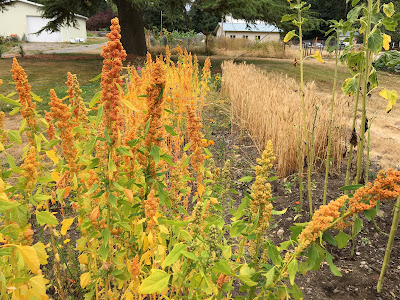When tied with a ribbon, golden bundles of wheat make a beautiful natural decoration for your home. Last spring, when there was a shortage of flour in the grocery stores due to the pandemic, we decided we'd experiment with growing wheat. We came up with the idea when we were cleaning out our pantry and realized we had a small package of Bob's Red Mill wheat berries. I was curious whether wheat berries that had been processed and packaged as a food product would be viable for growing in the garden.

Turns out, the wheat berries were indeed viable and we had a nice little harvest of wheat in late summer. But by then, flour was once again readily available in the stores, and in fact we have been enjoying baking with the inexpensive and enormous bags of organic Central Baking Company flour that is now available at Costco. In learning how to process wheat into flour, we decided that the wear and tear it would put on our food processor wasn't worth it for the small amount of flour we would be producing. I think I only grew enough wheat to make one loaf of bread.
As you can see in the photo above (on the right side of the photo), we only grew a small patch of wheat. On the left and toward the front is a patch of quinoa. There were also several tall sunflowers growing in this garden, which was in our side yard near the house.
Here is what the grain garden looked like from the front, nearer to the house. The lovely patch also included many flowers: zinnias, cosmos, forget-me-nots, marigolds, echinacea. Additionally, I sprinkled a package of wildflower seeds in there, and as a result some odd-looking flowers (or weeds?) we never could accurately identify filled in the patch.
Anyhow, in late August I cut down the wheat and the quinoa. The quinoa was placed on a drying rack and allowed to sit for several weeks, until the stems were very dry. The wheat was already dry and so I was able to make use of it right away.
Since we decided not to use the wheat as food, we began looking at images of wheat decorations online. Making bundles of wheat and placing them in vases was the simplest thing to do. All we had to do was gather up handfuls of the wheat stems, cut the bottom ends of the stems to make the bundles even at the bottom, and place them into vases. The wheat decorations have been lovely to see in our living room and dining room this fall.
The only problem we've encountered in having bundles of wheat as decorations in our home is that our cat, Grey Guy, loves to nibble on the wheat. Late at night, he gets up on the table or jumps up onto the fireplace mantle, and he munches away at the dried wheat kernels. Every morning, I find bits of wheat casings and broken stems around each vase, evidence of his late night snacking.
More recently, Grey Guy has gotten bolder and is caught during the day. "Stop eating the wheat!" we yell at him, and he jumps down.
This House with Knotty Pine
See many more photos of our house with its knotty pine walls in our e-book,
This House with Knotty Pine.
Click to download your copy from the Amazon bookshelf (for reading on iOS, Android, Mac, and PC using the
free Kindle app).
In the book, which you can
download and view now, you'll discover how we stumbled upon our unique home. The house was once part of a dairy farm, but it had fallen into disrepair over the years. Despite the sad state of the house, the solid planks of knotty pine throughout were still in great shape. Included are photos of the renovation plus many more photos of each of the eight rooms decorated.
Click to see the book on Amazon.
We invite you to download your copy of the book, which follows our journey as we share what we learned while renovating and decorating a house with its vintage knotty pine walls. See photos of our rooms from start to finish and throughout the seasons.







Comments
Post a Comment
Thank you so much for submitting a comment! All comments are reviewed by our moderator before being posted to the blog, in an effort to help control spam.